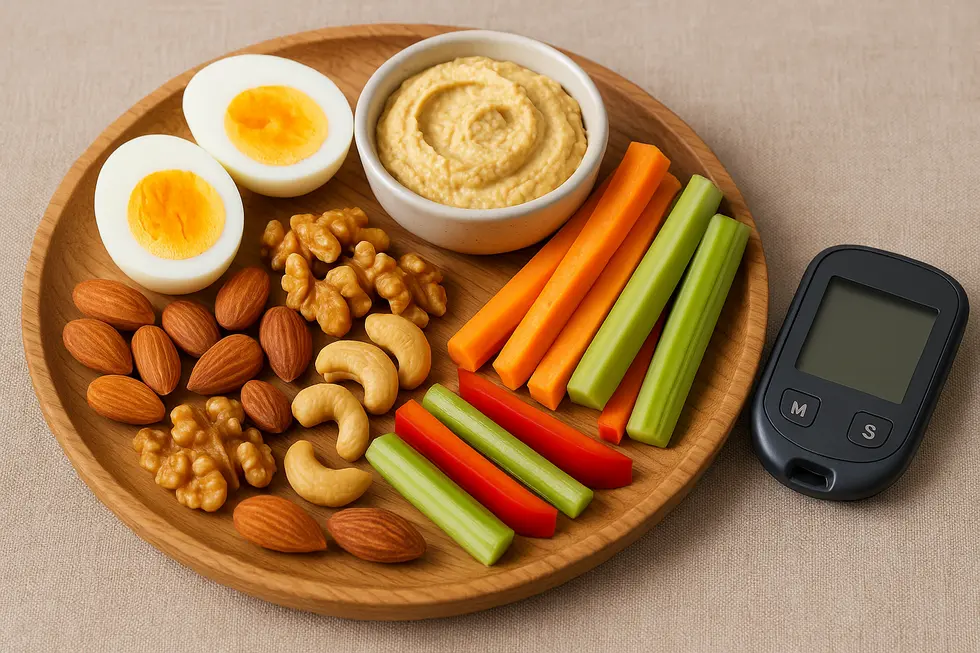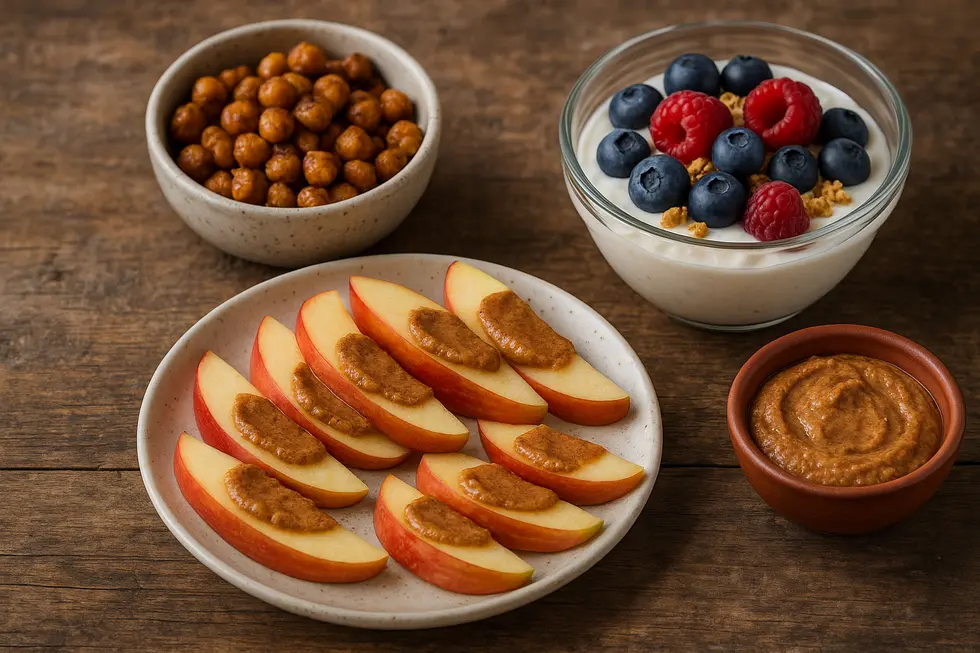Managing blood sugar levels is crucial for diabetics and those seeking consistent energy. Low glycemic index (GI) snacks play a significant role in this process, ensuring stability in blood sugar by preventing dramatic spikes and crashes. Dive deeper into how these snacks assist in managing blood sugar and explore innovative recipes to incorporate into your diet for ongoing health benefits.
Harnessing the Power of Low GI Snacks for Optimal Blood Sugar Management

Intricate and dynamic, the glycemic index (GI) serves as a compass guiding us through the complex interplay between food and blood sugar levels. Low glycemic index snacks, a category within this dietary landscape, are an essential tool for anyone aiming to manage their blood sugar effectively. Strategically selecting snacks not only optimizes energy distribution throughout the day but also aids in long-term health maintenance by ensuring more stable blood sugar levels.
Understanding the GI means diving into how foods affect our bodies. The index ranks foods based on how rapidly they raise blood glucose levels compared to pure glucose. Foods scoring lower on the GI, usually at 55 or below, digest gradually, facilitating a slow release of glucose. This steady entry of glucose into the bloodstream prevents the rapid spikes and sudden drops often associated with high GI foods, which can lead to energy crashes and increased feelings of hunger. Moreover, the sustained energy release from low GI snacks can also significantly improve insulin sensitivity, reducing the risk of insulin resistance—a precursor to type 2 diabetes.
The benefits of choosing low-GI snacks extend far beyond just energy stability. Regular consumption of these foods has been associated with decreased risks of chronic diseases, including obesity, heart disease, and type 2 diabetes. By minimizing the rapid oscillations in blood glucose levels that high-GI foods provoke, the body experiences a more balanced metabolic state. Over time, this steadiness can contribute to more favorable health outcomes, highlighting the importance of deliberate snack choices.
For those looking to dive into practical examples, the repertoire of low GI snacks is vibrant and varied. Whole grains and legumes such as brown rice, quinoa, garnet beans, and lentils offer an abundance of fiber and ensure a slower digestion process. This fiber not only helps stabilize glucose levels but also conveys a multitude of other health benefits, including improved gut health. Almonds and sunflower seeds present another superb option. Their rich composition of healthy fats and protein further helps blunt the glycemic impact of meals, allowing for more controlled energy levels and prolonged satiety.
Among the more creative options are non-starchy vegetables paired with hummus. Vegetables introduce delectable crunchiness alongside a host of essential nutrients, while hummus contributes a protein and fiber boost, all without causing a significant shift in blood glucose levels. Similarly, a Greek yogurt parfait—consisting of plain, unsweetened Greek yogurt coupled with fresh berries and a sprinkle of nuts or chia seeds—creates a harmonious blend of protein, fiber, antioxidants, and healthy fats. This combination excels in managing post-snack blood sugar spikes, embodying the essence of balanced nutrition.
To maximise the benefits of these snacks, it’s crucial to combine carbohydrates with protein and healthy fats. This combination facilitates slower digestion and a more gradual glucose release into the bloodstream, further promoting blood sugar stability. The choice of whole food-based snacks rich in fiber is also pivotal, as fiber’s role in decelerating digestion is well-documented.
Moreover, consider adopting simple techniques to further reduce the glycemic impact of carbohydrate-rich snacks. As suggested by a Harvard-trained nutritionist, heating and then cooling carbohydrate staples like rice or potatoes modifies their starch content, enhancing resistant starch and consequently lowering their GI. Such techniques are invaluable for anyone looking to maintain tight control over their post-meal glucose levels. Learn more about the benefits of low glycemic foods.
It’s important to remain mindful of what is consumed alongside these snacks. Avoiding processed, high-sugar snacks or sugary beverages can significantly affect blood sugar stability. Substituting these with hydrating options like infused water or herbal teas can provide refreshing alternatives without the added sugar burden.
Ultimately, harnessing the power of low-GI snacks requires more than just choosing the right foods. Combining them wisely and preparing them thoughtfully, while staying informed about their broader health implications, will enable you to manage blood sugar effectively. These strategies are not just about maintaining glucose levels—they are also about embracing a lifestyle that supports long-term wellness and vitality with each satisfying bite. For more strategies on managing diabetes through nutrition, explore further insights from this external resource.
Savor and Sustain: Innovative Low Glycemic Index Snack Recipes

Embarking on a journey to maintain stable blood sugar levels necessitates the integration of low glycemic index (GI) foods into everyday life. Not only do these foods help in avoiding energy spikes and crashes, but they also bring a variety of flavors and textures to delight the palate. In the realm of snacks, innovation can transform simple staples into culinary delights, allowing individuals to enjoy their daily routines without sacrificing health.
One of the most versatile and innovative snacks is roasted makhana. Often overlooked outside of Indian cuisine, makhana, or fox nuts, offer a delightful crunch similar to popcorn but with the added benefit of a low glycemic index. Roasting makhana in a small amount of ghee or olive oil, then seasoning with spices such as cumin, turmeric, or chili, elevates its flavor profile while keeping it a healthy choice. Unlike typical corny kernels, makhana is high in protein and fiber, offering sustenance without a spike in your blood sugar.
For a savory and protein-rich option, hard-boiled eggs make an exceptional snack. With zero sugar content and a high dose of protein, eggs can be jazzed up with simple additions like a sprinkle of smoked paprika or a dash of sea salt. These embellishments enhance the egg’s natural flavors, providing a rich and satisfying portion of sustained energy. Moreover, they fit easily into any meal prep routine, ensuring you have a dependable snack to carry through the day.
Those with a sweet tooth will find healthy banana blondies an inventive way to enjoy a low GI treat. Eschewing traditional butter for creamy nut butter and substituting refined sugar with maple syrup results in a dessert that is not only healthier but just as indulgent. The use of coconut flour, gluten-free by nature and high in fiber, remarkably slows the sugar digestion process, allowing for a gradual release of energy. These blondies can be further customized with the addition of chocolate chips or cinnamon for those extra layers of flavor without compromising their health benefits.
Meanwhile, reinventing toast with healthy sweet potato slices opens up a world of possibilities. Acting as a wholesome alternative to high-GI bread, sweet potato creates a hearty base for toppings. When layered with creamy lemon ricotta, fresh raspberries, and crunchy walnuts, this snack becomes a delightful dance of textures and flavors. Sweet potatoes, with their moderate GI, keep the blood sugar curve smooth, while ricotta and walnuts introduce healthy fats and protein into the mix.
For a fast, portable snack, consider diving into the simplicity of homemade peanut butter granola bars. Made with just five core ingredients—rolled oats, natural peanut butter, maple syrup, chocolate chips, and eggs—these bars can be a salvation during snack time. Their gluten-free and customizable nature means you can modify them with different nut butters or include seeds and dried fruits to cater to personal tastes. These granola bars pair the chewy texture of oats and the richness of peanut butter for an altogether fulfilling snack experience.
Exploring the myriad of low GI snacks available not only sustains energy levels but offers varied taste experiences. Each mentioned snack maintains a focus on balanced macronutrients—protein, fiber, and healthy fats—that support long-term energy storage rather than rapid glucose surges. For those seeking more insight and inspiration, The Real Food Dietitians is a treasure trove of recipes waiting to be explored. For a deeper understanding of how these ingredients contribute to overall health and their benefits specific to diabetes management, the advantages of choosing low-glycemic foods are noteworthy.
By integrating innovative low-GI snacks into your lifestyle, you can maintain stable blood sugar levels effortlessly while enjoying delightful moments of culinary creativity. Whether it’s a handful of well-seasoned makhana, a couple of banana blondies, or a quick sweet potato toast, these snacks contribute to a balanced diet that honors both nutrient needs and the pleasure of eating.
Final thoughts
Incorporating low glycemic index snacks into your daily routine can be a game-changer for maintaining steady energy levels and managing blood sugar. These snacks not only offer nutritional benefits but also introduce delicious options to enrich your diet. Make informed choices and explore diverse recipes to enjoy a balanced lifestyle.
Don’t just read about better health—live it. Download the Glycemic Index Guide Tracker today to start making smarter food choices, track your glucose, and stay on top of your nutrition—all in one app.
About us
Glycemic Index Guide Tracker is a powerful yet easy-to-use mobile app designed to help you make informed dietary choices by tracking the glycemic index (GI) and glycemic load (GL) of the foods you eat. Whether you’re managing diabetes, following a low-carb or keto diet, or simply aiming to maintain steady energy and better health, the app offers a comprehensive food database, nutrition and glucose tracking tools, weight monitoring, and curated low-GI recipes—all in one intuitive interface. It’s your go-to companion for understanding how different foods affect your blood sugar and for building smarter eating habits.


Leave a Reply